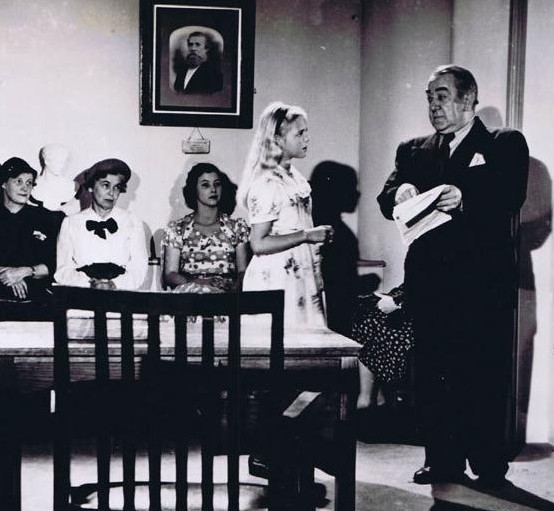by Stephen Vagg
Very few films were made in Australia in the 1950s – Wherever She Goes was one of them. It doesn’t enjoy much of a reputation, even among Aussie film buffs and it’s definitely no classic, but it’s a sweet little movie.
 It’s about the early years in the life of Eileen Joyce, little remembered today but in the ‘30s, ‘40s and ‘50s, she one of the most famous pianists in the world, and she was an Aussie. If the concept of a famous pianist is slightly weird today, it wasn’t so eighty years ago – it helped that Joyce was very beautiful as well as talented, and she leaned in to her looks, carefully choosing her own gowns and hair. She toured the world and regularly sold out large venues; her piano playing was heard on films such as The Seventh Veil, Brief Encounter and Quartet, and she appeared as herself in movies like A Girl in a Million and Trent’s Last Case. A heavily fictionalised book was written on Joyce’s life, Prelude – this formed the basis of the film Wherever She Goes.
It’s about the early years in the life of Eileen Joyce, little remembered today but in the ‘30s, ‘40s and ‘50s, she one of the most famous pianists in the world, and she was an Aussie. If the concept of a famous pianist is slightly weird today, it wasn’t so eighty years ago – it helped that Joyce was very beautiful as well as talented, and she leaned in to her looks, carefully choosing her own gowns and hair. She toured the world and regularly sold out large venues; her piano playing was heard on films such as The Seventh Veil, Brief Encounter and Quartet, and she appeared as herself in movies like A Girl in a Million and Trent’s Last Case. A heavily fictionalised book was written on Joyce’s life, Prelude – this formed the basis of the film Wherever She Goes.
The movie was made by an independent film company, Faun Film Productions, which had links with Ealing Studios, who were making movies in Australia around this time (Bitter Springs, Eureka Stockade, etc). It was directed by a Briton, Michael Gordon, who was normally an editor; Wherever She Goes is the only feature he directed.
 The story for Wherever She Goes starts with little Eileen (played by Suzanne Parrett) living in rural Tasmania when she discovers music via the harmonica of a passing swagman. She visits Hobart, she sees a piano for the first time and becomes hooked. Her family moves to Kalgoorlie where dad (Nigel Lovell) has rotten luck on the goldfields, but Eileen manages to find a way to practice the piano and becomes very good (it’s cute how the miners chip in to help her and the neighbours grumble about the little girl but support her). The movie ends with Eileen going to Perth, so it entirely skips her adult fame (which included an unhappy marriage to a man who died in the war and a nervous breakdown).
The story for Wherever She Goes starts with little Eileen (played by Suzanne Parrett) living in rural Tasmania when she discovers music via the harmonica of a passing swagman. She visits Hobart, she sees a piano for the first time and becomes hooked. Her family moves to Kalgoorlie where dad (Nigel Lovell) has rotten luck on the goldfields, but Eileen manages to find a way to practice the piano and becomes very good (it’s cute how the miners chip in to help her and the neighbours grumble about the little girl but support her). The movie ends with Eileen going to Perth, so it entirely skips her adult fame (which included an unhappy marriage to a man who died in the war and a nervous breakdown).
Suzanne Parrett is winning as the young Eileen, running around barefoot and getting into adventures. Tommy Drysdale is great as her brother; both performances have natural chemistry and presence. Nigel Lovell and Muriel Steinbeck offer solid support as mum and dad. George Wallace, star of several 1930s comedies has a small role as the manager of a talent competition – it was a shock to see him, he looks so old and tubby (this was his last feature). Joyce appears as herself at the beginning and ending of the movie. Parrett’s “hand double” for the piano scenes was pianist Pamela Page, who was part of a famous piano playing duo with her husband, Max Olding.
Wherever She Goes is not a masterpiece, but it’s the sort of bread-and-butter biopic Australia should (and could) have made more of: it’s got engaging child actors, location filming in Tasmania and Western Australia, plenty of music and a good heart. The movie was not a huge hit, though it had a long life… it popped up on television a bit when we were growing up and had a quite wide release in the US. Faun made no more movies.
Someone should make an Eileen Joyce biopic today. It would be great boomer cinema – costumes, music, stars, war, romance, death, poverty, nervous breakdowns, sexist villains saying things like “women can’t play the piano” and whatnot. Just putting that out there.

The author would like to thank Graham Shirley for his assistance with this article. Unless otherwise specified, all opinions are those of the author.



